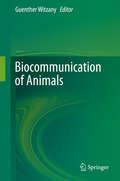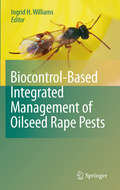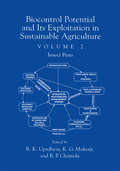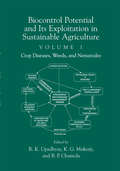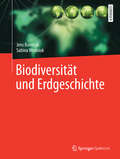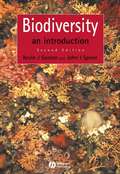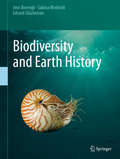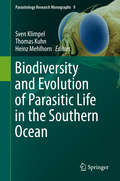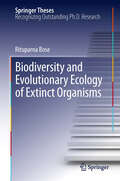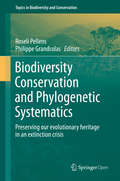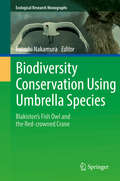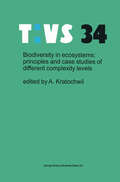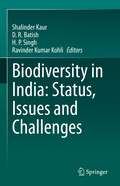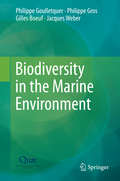- Table View
- List View
Biocommunication of Animals
by Guenther WitzanyEvery coordination within or between animals depends on communication processes. Although the signaling molecules, vocal and tactile signs, gestures and its combinations differ throughout all species according their evolutionary origins and variety of adaptation processes, certain levels of biocommunication can be found in all animal species: (a) Abiotic environmental indices such as temperature, light, water, etc. that affect the local ecosphere of an organism and are sensed, interpreted. (b) Trans-specific communication with non-related organisms.(c) Species-specific communication between same or related species. (d) Intraorganismic communication, i.e., sign-mediated coordination within the body of the organism. This book gives an overview of the manifold levels of animal communication exemplified by a variety of species and thereby broadens the understanding of these organisms.
Biocommunication of Archaea
by Guenther WitzanyArchaea represent a third domain of life with unique properties not found in the other domains. Archaea actively compete for environmental resources. They perceive themselves and can distinguish between ‘self’ and ‘non-self’. They process and evaluate available information and then modify their behaviour accordingly. They assess their surroundings, estimate how much energy they need for particular goals, and then realize the optimum variant. These highly diverse competences show us that this is possible owing to sign(aling)- mediated communication processes within archaeal cells (intra-organismic), between the same, related and different archaeal species (interorganismic), and between archaea and nonarchaeal organisms (transorganismic). This is crucial in coordinating growth and development, shape and dynamics. Such communication must function both on the local level and between widely separated colony parts. This allows archaea to coordinate appropriate response behaviors in a differentiated manner to their current developmental status and physiological influences. This book will orientate further investigations on how archaeal ecosphere inhabitants communicate with each other to coordinate their behavioral patterns and whats the role of viruses in this highly dynamic interactional networks.
Biocommunication of Phages
by Guenther WitzanyThis is the first book to systemize all levels of communicative behavior of phages. Phages represent the most diverse inhabitants on this planet. Until today they are completely underestimated in their number, skills and competences and still remain the dark matter of biology. Phages have serious effects on global energy and nutrient cycles. Phages actively compete for host. They can distinguish between ‘self’ and ‘non-self’ (complement same, preclude others). They process and evaluate available information and then modify their behaviour accordingly. These diverse competences show us that this capacity to evaluate information is possible owing to communication processes within phages (intra-organismic), between the same, related and different phage species (interorganismic), and between phages and non-phage organisms (transorganismic). This is crucial in coordinating infection strategies (lytic vs. lysogenic) and recombination in phage genomes.In 22 chapters, expert contributors review current research into the varying forms of phage biocommunication and Phagetherapy. Biocommunication of Phages aims to assess the current state of research, to orient further investigations on how phages communicate with each other to coordinate their behavioral patterns, and to inspire further investigation of the role of non-phage viruses (non-lytic, non-prokaryotic) in these highly dynamic interactional networks.
Biocontrol-Based Integrated Management of Oilseed Rape Pests
by Ingrid H. H. WilliamsOilseed rape is a major arable crop in both Europe and North America. It is attacked by unique complexes of insect pests still largely controlled through the application of chemical insecticides. Crop management systems for the future must combine sustainability with environmental acceptability to satisfy both social and economic demands. This book, in its 17 chapters each led by a world expert, reviews research progress towards developing integrated pest management systems for the crop that enhance conservation biocontrol. This approach is particularly timely because of the development in Europe of insecticide resistance in the pollen beetle, a major pest of the crop. The past decade has seen considerable progress in our knowledge of the parasitoids and predators that contribute to biocontrol, of their distribution patterns, and their behavioural ecology, both within and without the crop. There is potential for natural enemy conservation through modification of within-field crop husbandry practices, as well as, on the landscape scale, through habitat manipulation to encourage vegetational diversity. This book will prove invaluable as a text for researchers, university teachers, graduate scientists, extension workers and growers involved in integrated pest management.
Biocontrol of Lepidopteran Pests: Use of Soil Microbes and their Metabolites (Soil Biology #43)
by K. Sowjanya Sree Ajit VarmaThis volume describes the various applications of entomopathogenic soil microorganisms in the management and control of the devastating lepidopteran pest. An introduction describes the insecticidal properties of viruses, bacteria, fungi, nematodes and their metabolites, as well as their applications in the context of crop improvement. Subsequent chapters focus on topics such as insecticidal proteins; the role of nucleopolyhedroviruses; Bt toxins and their receptors; control of lepidopterans using entomopathogenic fungi; management of cotton defoliators; and sustainable use of entomopathogenic nematodes and their bacterial symbionts. An overview of culture collections of entomopathogenic microorganisms rounds out the volume.
Biocontrol Potential and its Exploitation in Sustainable Agriculture: Volume 2: Insect Pests
by Rajeev K. Upadhyay K. G. Mukerji B. P. ChamolaPlant based Biotechnology has come to represent a means of mitigating the problems of global food security in the twenty first century. Products and processes in agriculture are increasingly becoming linked to science and cutting edge technology, to enable the engineering of what are in effect, designer plants. One of the most successful, non chemical approaches to pest management and disease control, which seeks a solution in terms of using living organisms to regulate the incidence of pests and and pathogens, providing a `natural control' while still maintaining the biological balance with the ecosystem. This volume, describes the various biological agents used to control insect pests of a variety of crops. Readers may also be interested in Volume 1: Crop diseases, Weeds and Nematodes, published in December 2000, ISBN 0-306-46460-8.
Biocontrol Potential and its Exploitation in Sustainable Agriculture: Crop Diseases, Weeds, and Nematodes
by Rajeev K. Upadhyay K. G. Mukerji B. P. ChamolaPlant based biotechnology has come to represent a means of mitigating the problems of global food security in the twenty-first century. Products and processes in agriculture are increasingly becoming linked to science and cutting edge technology, to enable the engineering of what are in effect, designer plants. One of the most successful , non-chemical approaches to pest management and disease control is biological control, which seeks a solution in terms of using living organisms to regulate the incidence of pests and pathogens, providing a natural control' while still maintaining the biological balance with the ecosystem. This volume, (the first of two), addresses the different types of biocontrol for different pests, namely, crop diseases, weeds and nematodes, and details the biology of both the pest and its enemies, which is vital for efficient use of biological control. The book has numerous contributors who are authorities in their fields, and would be an asset to those who have interest in sustainable agriculture and crop productivity.
Bioconversion of Waste Materials to Industrial Products (Elsevier Applied Biotechnology Series)
by A. M. MartinBy covering both the general principles of bioconversion and the specific characteristics of the main groups of waste materials amenable to bioconversion methods, this new book provides the chemical, biochemical, agrochemical and process engineer with clear guidance on the use of these methods in devising a solution to the problem of industrial waste products.
Biodegradation of Pesticides
by Fumio Matsumura and C. R. Krishna MurtiWhen first developed, chlorinated pesticides such as DDT, dieldrin, and mirex were received with open arms, quickly becoming popular as effective, economic agents against pests. But evidence began to mount that residues of these chemicals remained in the environment, not breaking down, often appearing in plants and animals. By the late seventies many pesticides had achieved a terrible notoriety and were subsequently banned in a number of countries. Of tremendous concern, then, is the persistence of pesticides in the environment. The major thrust of research and development in the area of pesticides has properly been the creation of substances that are both effective and degradable. Yet in order to successfully promote the use of biodegradable pesticides, one must fully understand the mechanism of degradation, and it is to this vital subject that we address ourselves in the present volume. According to the Biodegradation Task Force, Safety of Chemicals Com mittee, Brussels (1978), biodegradation may be defined as the molecular degradation of an organic substance resulting from the complex action of living organisms. A substance is said to be biodegraded to an environmentally acceptable extent when environmentally undesirable properties are lost. Loss of some characteristic function or property of substance by biodegradation may be referred to as biological transformation.
Biodeterioration 7
by D. R. Houghton Smith H. O. EgginsBecause of the magnificent response to the call for papers for the 7th International Biodeterioration Symposium held at Cambridge, UK, some difficulties have been experienced in the editing of these proceedings. The numbers of papers submitted exceeded expectation and because of this it has been necessary to accommodate those not actually in the proceedings into the International Biodeterioration journal. A small number of papers were not suitable for publication and were therefore eliminated. Many authors disregarded the guidelines laid down for the length of submitted papers. However, every attempt has been made to accommodate the maximum number of contributions in the proceedings. The original selection included those which most nearly conformed to the length requirement. Even so this has meant, in many cases, cutting down the text, eliminating tables and/or illustrations and pruning the reference list. When references have been trimmed a note has been included to the effect that an extended list may be obtained from the author/senior author. Where it was not possible to carry out these procedures without seriously altering the text and the import of the paper they have been included amongst those to be published in the journal International Biodeterioration. The exceptions to the procedures outlined above are the invited review papers which have been presented in full. Happily, the authors have been conscientious in keeping to the guidelines laid down for these contributions.
Biodiversität und Erdgeschichte
by Jens Boenigk Sabina WodniokDieses inspirierende und motivierende Lehrbuch zeichnet fächerübergreifend ein beeindruckendes Gesamtbild der biologischen Vielfalt. Spannende Aspekte der Evolution der Erde und des Lebens werden durch interdisziplinäre Verknüpfung geowissenschaftlicher und biowissenschaftlicher Aspekte aus einer ganz neuen Perspektive anschaulich vermittelt. Der Schwerpunkt liegt hierbei – unter Einbeziehung aktuellster wissenschaftlicher Erkenntnisse – auf dem Verständnis von Konzepten und Mechanismen.Dieses Buch richtet sich an Studierende der Bio- und Geowissenschaften und an alle an der Vielfalt des Lebens interessierten Leser. Das innovative Lehrbuchkonzept regt – gleichzeitig als Lesebuch, Bilderbuch und Lexikon der organismischen Biologie – sowohl Anfänger als auch Fortgeschrittene zu einem visuellen und intuitiven Lernen an. Jede Doppelseite bietet ein in sich geschlossenes, anschaulich bebildertes Kapitel mit themenbezogenem Glossar und weiterführenden Verweisen. Für Dozenten und Lehrer, für Schule und Hochschule bietet dieses Buch ein reichhaltiges Nachschlagewerk und einen umfassenden Fundus an didaktisch durchdachten und lernfreundlich illustrierten Lehrmaterialien.Der Inhalt reicht von der Entstehung der Erde über die geowissenschaftlichen Rahmenbedingungen und die Verknüpfung zwischen biologischer und geologischer Evolution bis zur Entstehung des Menschenvon grundlegenden Mechanismen der Entstehung und Erhaltung der Diversität bis zur globalen Verteilung der heutigen Biodiversitätvon den Anfängen der biologischen Systematik in der griechischen Philosophie und der Bibel über die darwinsche Evolution und die Struktur und Funktion von Arten und Organismen bis zu den modernen Erkenntnissen der Megasystematik und Phylogenie.Mit diesem einzigartigen Konzept verschafft dieses Lehrbuch einen soliden Überblick über die Erdgeschichte und Biodiversität. Die Verknüpfung der verschiedenen Fachdisziplinen fördert das Verständnis übergeordneter Prinzipien und naturwissenschaftlicher Zusammenhänge.
Biodiversity: An Introduction
by Kevin J. Gaston John I. SpicerCLICK HERE TO DOWNLOAD ARTWORK This concise introductory text provides a complete overview of biodiversity - what it is, how it arose, its distribution, why it is important, human impact upon it, and what should be done to maintain it. Timely overview of the serious attempts made to quantify and describe biodiversity in a scientific way Acts as an easy entry point into the primary literature Provides real-world examples of key issues, including illustrations of major temporal and spatial patterns in biodiversity Designed primarily with undergraduate students and course lecturers in mind, it will also be of interest to anyone who requires an overview of, and entry to, the vast literature on these topics. All the figures included in the book are downloadable from the Blackwell Publishing website
Biodiversity: An Introduction
by Kevin J. Gaston John I. SpicerCLICK HERE TO DOWNLOAD ARTWORK This concise introductory text provides a complete overview of biodiversity - what it is, how it arose, its distribution, why it is important, human impact upon it, and what should be done to maintain it. Timely overview of the serious attempts made to quantify and describe biodiversity in a scientific way Acts as an easy entry point into the primary literature Provides real-world examples of key issues, including illustrations of major temporal and spatial patterns in biodiversity Designed primarily with undergraduate students and course lecturers in mind, it will also be of interest to anyone who requires an overview of, and entry to, the vast literature on these topics. All the figures included in the book are downloadable from the Blackwell Publishing website
Biodiversity: Threats and Conservation (Translating Animal Science Research)
by R. C. SobtiThe term "biodiversity" or "biological diversity" describes the variety of living beings on Earth encompassing microorganisms, plants, animals, and ecosystems, such as coral reefs, forests, and deserts. In fact, it also represents a wealth of biological resources available to us. Today, instead of exploring and preserving its unmapped biodiversity, mankind has gone away from mother nature, conquering the domain through relentless exploitation. This has resulted in an ecological imbalance and thereby has posed serious threat to biodiversity. Declining biodiversity is, therefore, a concern for countless reasons. Biodiversity’s wealth of genetic information can be conserved by storing biological material from endangered species. Cell lines, gametes, and embryos are preserved so that in case a species becomes extinct or there is a need to increase the population of the species, then cloning and artificial reproductive techniques can be used to revive and reproduce the said species. The present volume discusses the biodiversity of specific animal groups, such as cnidarians and fish, as well as potential risks to and methods for conserving some of them. The following important aspects are addressed: 1. The importance of biodiversity in maintaining ecosystem balance for sustainability 2. The emerging role of biodiversity as a source of important materials, pharmaceuticals, food, and so on as such or through genetic manipulation to meet the contemporary and future challenges 3. The impact of environment degradation on biodiversity and conservation in a changing environment 4. Conventional and emerging biotechnological techniques to conserve biodiversity The book is intended for academics, scientists, and naturalists working in the fields of biology, biochemistry, biophysics, and biomedical sciences.
Biodiversity: Threats and Conservation (Translating Animal Science Research)
by Rc SobtiThe term "biodiversity" or "biological diversity" describes the variety of living beings on Earth encompassing microorganisms, plants, animals, and ecosystems, such as coral reefs, forests, and deserts. In fact, it also represents a wealth of biological resources available to us. Today, instead of exploring and preserving its unmapped biodiversity, mankind has gone away from mother nature, conquering the domain through relentless exploitation. This has resulted in an ecological imbalance and thereby has posed serious threat to biodiversity. Declining biodiversity is, therefore, a concern for countless reasons. Biodiversity’s wealth of genetic information can be conserved by storing biological material from endangered species. Cell lines, gametes, and embryos are preserved so that in case a species becomes extinct or there is a need to increase the population of the species, then cloning and artificial reproductive techniques can be used to revive and reproduce the said species. The present volume discusses the biodiversity of specific animal groups, such as cnidarians and fish, as well as potential risks to and methods for conserving some of them. The following important aspects are addressed: 1. The importance of biodiversity in maintaining ecosystem balance for sustainability 2. The emerging role of biodiversity as a source of important materials, pharmaceuticals, food, and so on as such or through genetic manipulation to meet the contemporary and future challenges 3. The impact of environment degradation on biodiversity and conservation in a changing environment 4. Conventional and emerging biotechnological techniques to conserve biodiversity The book is intended for academics, scientists, and naturalists working in the fields of biology, biochemistry, biophysics, and biomedical sciences.
Biodiversity and Earth History
by Jens Boenigk Sabina Wodniok Edvard GlücksmanThis uniquely interdisciplinary textbook explores the exciting and complex relationship between Earth’s geological history and the biodiversity of life. Its innovative design provides a seamless learning experience, clarifying major concepts step by step with detailed textual explanations complemented by detailed figures, diagrams and vibrant pictures. Thanks to its layout, the respective concepts can be studied individually, as part of the broader framework of each chapter, or as they relate to the book as a whole. It provides in-depth coverage of: - Earth’s formation and subsequent geological history, including patterns of climate change and atmospheric evolution; - The early stages of life, from microbial ‘primordial soup’ theories to the fossil record’s most valuable contributions; - Mechanisms of mutual influence between living organisms and the environment: how life changed Earth’s history whilst, at the same time, environmental pressures continue to shape the evolution of species; - Basic ideas in biodiversity studies: species concepts, measurement techniques, and global distribution patterns; - Biological systematics, from their historical origins in Greek philosophy and Biblical stories to Darwinian evolution by natural selection, and to phylogenetics based on cutting-edge molecular techniques. This book’s four major sections offer a fresh cross-disciplinary overview of biodiversity and the Earth’s history. Among many other concepts, they reveal the massive diversity of eukaryotes, explain the geological processes behind fossilisation, and provide an eye-opening account of the relatively short period of human evolution in the context of Earth’s 4.6 billion-year history. Employing a combination of proven didactic tools, the book is simultaneously a reading reference, illustrated guide, and encyclopaedia of organismal biology and geology. It is aimed at school- and university-level students, as well as members of the public fascinated by the intricate interrelationship of living organisms and their environment.
Biodiversity and Evolution of Parasitic Life in the Southern Ocean (Parasitology Research Monographs #9)
by Sven Klimpel Thomas Kuhn Heinz MehlhornThe Southern Oceans including Antarctic regions are peculiar and very sensitive water biotopes, where animal life and species interrelations are only poorly investigated. Especially the influence of parasites on their host species needs intensive consideration in times of global warming and worldwide pollution. Both factors may influence the finely balanced interrelationships between parasites and endangered hosts especially in specialized regions such as Antarctica. Before this background the present book offers a broad spectrum of important parasite-host interrelations in times of ecosystem changes written by experienced and renown international specialists.
Biodiversity and Evolutionary Ecology of Extinct Organisms (Springer Theses)
by Rituparna BoseIncreasing rate of species extinction in the present day will lead to a huge biodiversity crisis; eventually, this will lead to the paucity of non-renewable resources of energy making our Earth unsustainable in future. To save our mother planet from this crisis, studies need to be performed to discover abundant new fossil sites on Earth for continued access to oil-rich locations. Most importantly, a holistic approach is necessary in solving the present problem of biodiversity loss. This book presents newly developed quantitative models in understanding the biodiversity, evolution and ecology of extinct organisms. This will assist future earth scientists in understanding the natural and anthropogenic causes behind biodiversity crisis and ecosystem collapse. In addition, this study would be of great interest to exploration geologists and geophysicists in potentially unraveling natural resources from our sustainable Earth.
Biodiversity and Insect Pests: Key Issues for Sustainable Management
by Geoff M. Gurr Stephen D. Wratten William E. SnyderBiodiversity offers great potential for managing insect pests. It provides resistance genes and anti-insect compounds; a huge range of predatory and parasitic natural enemies of pests; and community ecology-level effects operating at the local and landscape scales to check pest build-up. This book brings together world leaders in theoretical, methodological and applied aspects to provide a comprehensive treatment of this fast-moving field. Chapter authors from Europe, Asia, Africa, Australasia and the Americas ensure a truly international scope. Topics range from scientific principles, innovative research methods, ecological economics and effective communication to farmers, as well as case studies of successful use of biodiversity-based pest management some of which extend over millions of hectares or are enshrined as government policy. Written to be accessible to advanced undergraduates whilst also stimulating the seasoned researcher, this work will help unlock the power of biodiversity to deliver sustainable insect pest management. Visit www.wiley.com/go/gurr/biodiversity to access the artwork from the book.
Biodiversity and Insect Pests: Key Issues for Sustainable Management
by Geoff M. Gurr Stephen D. Wratten William E. SnyderBiodiversity offers great potential for managing insect pests. It provides resistance genes and anti-insect compounds; a huge range of predatory and parasitic natural enemies of pests; and community ecology-level effects operating at the local and landscape scales to check pest build-up. This book brings together world leaders in theoretical, methodological and applied aspects to provide a comprehensive treatment of this fast-moving field. Chapter authors from Europe, Asia, Africa, Australasia and the Americas ensure a truly international scope. Topics range from scientific principles, innovative research methods, ecological economics and effective communication to farmers, as well as case studies of successful use of biodiversity-based pest management some of which extend over millions of hectares or are enshrined as government policy. Written to be accessible to advanced undergraduates whilst also stimulating the seasoned researcher, this work will help unlock the power of biodiversity to deliver sustainable insect pest management. Visit www.wiley.com/go/gurr/biodiversity to access the artwork from the book.
Biodiversity Conservation and Phylogenetic Systematics: Preserving our evolutionary heritage in an extinction crisis (Topics in Biodiversity and Conservation #14)
by Roseli Pellens Philippe GrandcolasThis book is about phylogenetic diversity as an approach to reduce biodiversity losses in this period of mass extinction. Chapters in the first section deal with questions such as the way we value phylogenetic diversity among other criteria for biodiversity conservation; the choice of measures; the loss of phylogenetic diversity with extinction; the importance of organisms that are deeply branched in the tree of life, and the role of relict species. The second section is composed by contributions exploring methodological aspects, such as how to deal with abundance, sampling effort, or conflicting trees in analysis of phylogenetic diversity. The last section is devoted to applications, showing how phylogenetic diversity can be integrated in systematic conservation planning, in EDGE and HEDGE evaluations. This wide coverage makes the book a reference for academics, policy makers and stakeholders dealing with biodiversity conservation.
Biodiversity Conservation Using Umbrella Species: Blakiston's Fish Owl and the Red-crowned Crane (Ecological Research Monographs)
by Futoshi NakamuraThis book focuses on Blakiston’s fish owl and the red-crowned crane as umbrella species. Healthy river, riparian and wetland ecosystems are necessary to maintain the populations of the two species. Both species have been revered by people since ancient times, but both are currently listed as endangered because of their small population sizes. The population decline of the two species can be mainly attributed to the degradation of the natural riparian and wetland habitats, which is associated with land use development.The populations of the two species are now recovering in Japan due to recent conservation and reproduction efforts, but the genetic diversity of the two species are still low due to previous bottleneck effects. To develop conservation and dispersal plans to establish the species over the East Asian mainland and on the island of Hokkaido, basic information, such as their regional distribution, genetic diversity, food availability, reproductive traits, and nesting, breeding, rearing, and commuting habitat, is essential. The intensive, collaborative studies conducted in Japan and Russia has clarified the status quo and the ecology of the two species. This is the first book that comprehensively compiles the above information for the mainland and island populations. In addition, it verifies their suitability as umbrella species of an ecosystem and the possibility of their future population expansion, taking into account changes in land use in Hokkaido, which is about to experience a dramatic decline in human population. As such, the book provides valuable information for students who wish to learn about these beautiful symbolic creatures, for NGOs engaged in conservation activities, and for managers who are involved in creating conservation plans and implementing restoration projects.
Biodiversity in ecosystems: principles and case studies of different complexity levels (Tasks for Vegetation Science #34)
by A. KratochwilThis volume does not aim at merely adding to the vast and increasing number of individual publications on `biodiversity'. Rather it is our objective to investigate biodiversity on the previously little studied coenosis and landscape levels. Phytosociological and animal-ecological fields are considered, as well as theoretical approaches to biodiversity and aspects of its application in nature and landscape protection and preservation. Since biodiversity has so far been predominantly studied in the Anglo-American area, it seemed to be of value to discuss this complex topic from a central and southern European viewpoint, based on data gathered in these regions, and thus to promote a global discussion.
Biodiversity in India: Status, Issues and Challenges
by Shalinder Kaur D. R. Batish H. P. Singh Ravinder Kumar KohliThis contributed book is based on the current status of biodiversity in India, issues and challenges faced by the authorities involved in conservation efforts, and the imperative role of various direct and indirect stakeholders in biodiversity conservation. The book discusses the current status of different forms of biodiversity in India, challenges faced by stakeholders, issues and reasons for biodiversity losses, and efforts by government through various laws, policies, and programs in a concise and comprehensive manner throughout its many chapters. In this way, readers can access diverse information on Indian biodiversity through this book. It is compiled by leading experts in the field of conservation. In 18 chapters, it covers biodiversity of both fauna and flora, on land and in aquatic ecosystems, legal and policy aspects, as well as innovative conservation tool and techniques. It is useful for undergraduates and graduate students and also educates policy planners, bureaucrats, foresters, and researchers in India and abroad.
Biodiversity in the Marine Environment
by Philippe Goulletquer Philippe Gros Gilles Boeuf Jacques WeberThe oceans cover over 70% of our planet. They are host to a biodiversity of tremendous wealth. Its preservation is now a global priority featuring in several international conventions and a confirmed objective of European policies and national strategies. Understanding the dynamics and the uses of the marine biodiversity is a genuine scientific challenge. Fourteen international experts have got together and identified five priority research themes to address the problem, based on analysing the state of knowledge.
